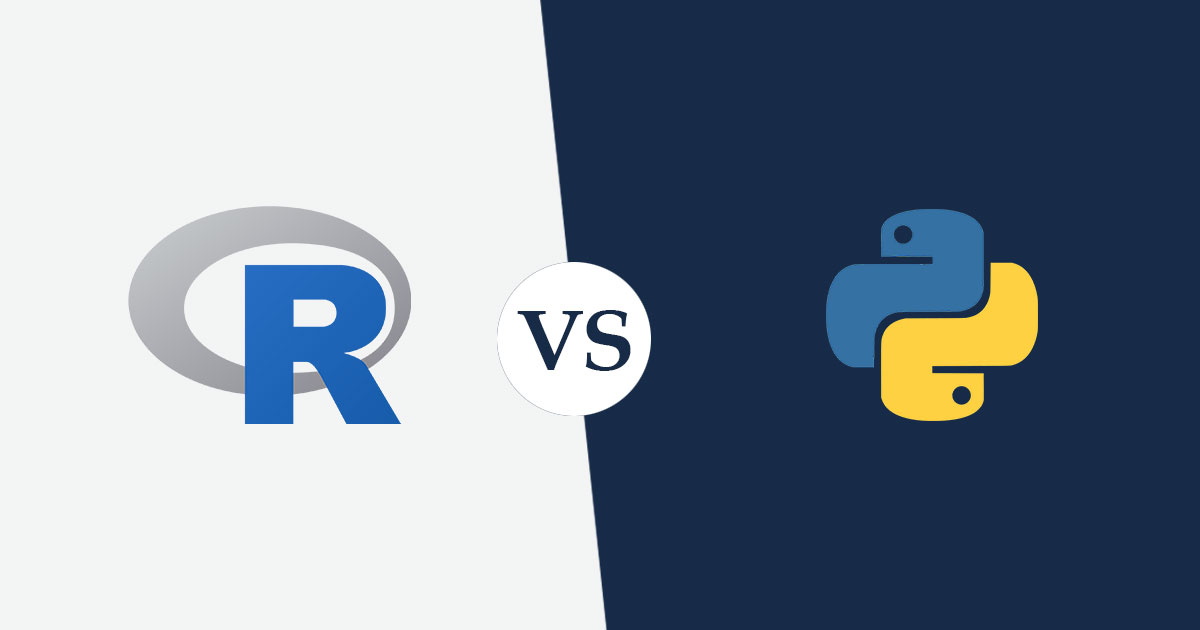The other day I had a debate with my colleague on R vs. Python, and of course, the most frequently asked question, which one scores better. Well, my answer was both. R and Python, both of which are the free and open source, and were developed in the early 1990s, are the two most popular programming languages used by data analysts and data scientists across the world. Both languages work wonders for machine learning. They are boons for people working with large datasets or creating complex data visualizations.
In this discussion, I intend to discuss the differences between these Python and R from a Data Science point of view. My observation of the two programming languages will touch areas like their usage, usability, learning curve, growth prospects, and of course, individual pros and cons. The discussion will also highlight areas where both are equally good. One cannot compare, but only make a choice based on individual business requirement or availability.
R vs. Python: Usability
R and Python are ranked amongst the most popular languages for data analysis, and both have their individual supporters and opponents. Python is widely admired for being a general-purpose language and comes with a syntax that is easy-to-understand. R, on the other hand, is developed keeping statisticians in mind, therefore more specific and has field-specific advantages such as great features for data visualization. R packages for a wide variety of statistical tasks using the CRAN task view; covers everything from Psychometrics to Genetics to Finance.
R is good for statistics-heavy projects and one-time dives into a dataset. Take, for example, text analysis, where you want to deconstruct paragraphs into words or phrases and then identify patterns, R is the best choice.
Python is more commonly used to build modules to create websites, interact with a variety of databases, and manage users. When drawing a comparison between Python and R, Python is better for building analytical tools. This is especially true if you are creating a web service to enable other people to upload datasets and find outliers.
R vs. Python: Libraries
Both Python and R come with sophisticated data analysis and machine learning packages to can give you a good start. Each has its own analysis, visualization, machine learning and data manipulation packages. The same applies to IDEs.
RStudio IDE is the obvious choice for working in an R development environment. R packages like dplyr, plyr and data.table are highly preferred for manipulating packages, stringr for string manipulation, ggvis and ggplot2 for data visualization, and caret for machine learning.
Python, on the other hand, comes with more number of development environments. Spyder, IPython Notebook, and Rodeo are good to start with. As for popular libraries, Python gives you numerous options to choose from; NumPy /SciPy for scientific computing, matplotlib to make graphs, scikit-learn for machine learning and pandas for data manipulation.
R vs. Python: Flexibility
Being a data analyst, one often needs to take a call; to choose Python or R, for better business value. While both languages have their own share of merits, the question of flexibility worries me a lot.
R is a specific programming language is meant for complicated data analysis, comes with several packages, and is available for implementing and statistical tests and models. But the solutions must be customized and not general.
Python being a general programming language comes with many libraries that are used for statistical work. It is also good for integration options and more streamlined approach to practicing novel tasks. You may write your own code for scripting a website or any web app. However, if you would ask me which language is more suitable for approaching a data science project, my answer would be R.
R vs. Python for data science: Usage
When it comes to usage in data science, experts are divided in their opinions. Some data scientists prefer R to Python because of its visualization libraries and interactive style. R comes with great abilities in data visualization, both static and interactive. Interactive visualization built with R packages like Plotly, Highcharter, Dygraphs, and Ggiraph take the interaction between the users and the data to a new level.
But again, if you are looking for higher performance or structured code Python is the go-to language. It is because Python has some of the best libraries such as SciKit-Learn, IPython, numpy, scipy, matplotlib, etc. NumPy is the foundational library for scientific computing in Python, and it introduces objects for multi-dimensional arrays and matrices, as well as routines that allow developers to perform advanced mathematical and statistical functions on those arrays with fewer codes. Matplotlib is the standard Python library for creating 2D plots and graphs.
Both Python and R have their individual merits. So, if you are a newbie working on a data science project, then I would advise you to use both R and Python interchangeably.
Python vs. R for Data Science: Lingua Franca
We have arrived at an age when a data scientist is not always somebody with a computer science background, nor is he a mathematician. More often, a data scientist is an innovator or visionary, whose futuristic approach goes beyond the barriers of academia. R is the data scientist’s best instrument. R codes and packages are great for communicating ideas and concepts. R is the lingua franca for data science projects today.
To work in a Python development environment, one should ideally have a computer science or programming background. Learning about the different Python libraries like SciKit-Learn, IPython, numpy, scipy, matplotlib, are best for people with a coding background.
R vs. Python: Learning Curve
Which is of the two programming languages is a better choice for learning? It is a common question that baffles many aspiring data analysts. Both R and Python, require a significant time investment, and one needs to have a thorough knowledge of either, for a promising career in data science.
When making a comparison between R and Python, I may say that R has a steep learning curve, and people without prior programming experience may find it difficult to grasp at the beginning. However, with extensive learning and practice programs, you may have a strong command over R.
Python, on the other hand, which focuses on readability and simplicity, is generally considered easier for programmers to pick up. Python being a more general programming language is useful building a website or making sense of command-line tools, especially for those with a background in statistics.
R vs. Python: Community
A programming language becomes known by its usage, and yes, by its users. The richer community a language has, the better are its chance of growth and sustenance. It is because people do not just write codes, they discuss, analyze, and geniuses, we know also dream about codes. A quick look any of the language communities will give you an inkling of the goings on in the minds of these master coders.
Any regular observer would know that R as a language has a rich community of more than 2 million users and that includes thousands of developers spread across the world. The community has packages widespread across actuarial analysis, finance, machine learning, web technologies, pharmaceuticals that can be of great help to predict component failure times, analyze genomic sequences, and optimize portfolios. user-generated documentation of active StackOverflow members has contributed greatly to the rapid adoption rate of R.
Python community, though slightly less powerful, is also gaining acceptance of the good number of StackOverflow members. General-purpose coding in Python continues to grow with remarkable user-contributed code and documentation by developers and programmers, data scientists, researchers, and students across the world.
R vs. Python: Licensing
When drawing a comparison between Python vs R for Data Science, one must not overlook the part on licensing. Most libraries used for Python have business-friendly distribution licenses, such as BSD or MIT that makes sharing of the software much easier. Both MIT and BSD are simple and permissive licenses, which allow people to use and distribute your code subject to with a few restrictions; the license must always be distributed with the code.
R libraries, on the other hand, are GPL or CC0, which makes distribution norms slightly stricter. The chief concern with GPL-2 and GPL-3 is distribution. Both GPL-2 and GPL-3 are “copy-left” licenses. So, anyone who distributes your code in a bundle must license the whole bundle in a GPL-compatible way. Also, to distribute modified versions of your code (derivative works) the source code must also be made available. GPL-3 is a little stricter than GPL-2. So, if you are looking for easier distribution licenses, I would say Python is a simpler option.
R vs. Python: The Winner
In the recent past, Python and R have been outdoing each other, when it comes to programming and application for Analytics, Data Science, and Machine Learning. Most of the common tasks which could be executed earlier in either of the two are now executable by both.
To make a choice between R and Python you need to depend completely on the use case and abilities. If you are from a statistical background then I would advise you to start with R. On the contrary, if you are an experienced programmer, choose Python for proficiency. At times, the level of analysis and development needed becomes a deciding factor. R is an obvious choice when you have a hardcore data science requirement. Python, on the other hand, is a better alternative for application development. Thus, the best solution is to make a smart move based on the domain needs, resource availability, and cost.
Both the languages are equally good. Each language has its pros and cons for different scenarios and tasks. The bottom line here is that it is difficult to place one before the other, Python or R. So, if you have already mastered Python and gained a few years of experience, you may also learn R, for more knowledge.
Conclusion
Learning both is always a boon for a career in data science. You may also enroll for a Data Analytics Course for more lucrative career options in Data Science. industry-relevant curriculum, pragmatic market-ready approach, Hands-on Capstone Project are some of the best reasons for choosing Digital Vidya.









Hi, Author Great Content!